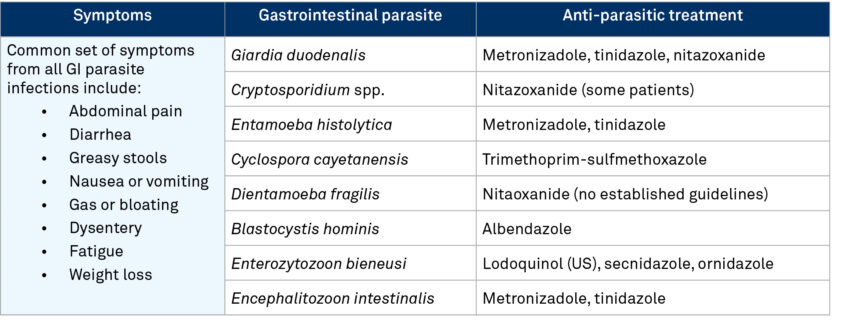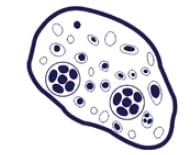Cryptosporidium: symptoms, prevention & treatment

Cryptosporidium symptoms
Cryptosporidium infection
Cryptosporidium spreads through the fecal-oral route by ingesting contaminated food or water. Transmission via recreational water activities is common due to Cryptosporidium’s ability to survive in moist environments for extended periods and resistance to chlorine. [1].
The disease burden in both developed and developing countries is likely to be underestimated partly due to the large number of asymptomatic or self-limiting cases, lack of newer diagnostic methods resulting in the reliance on microscopy for routine detection, which is associated with low specificity and sensitivity [2].
On average, Cryptosporidiosis symptoms start 7 days after infection and can last up to 2 weeks. [3]
Cryptosporidium usually causes asymptomatic or self-limiting diarrhea in healthy immunocompetent persons. However, it can progress to chronic diarrhea in immunocompromised individuals, including people living with HIV/AIDS. This may result in significant morbidity and mortality if appropriate measures are not promptly initiated [4].
The benefits of employing molecular syndromic testing for overlapping gastrointestinal signs and symptoms
Genetic Signatures' EasyScreen Gastrointestinal Parasite Detection Kit can detect 8 parasite pathogens from a single sample, in a single test, increasing the likelihood of identifying co-infections from multiple parasites that might be missed with traditional testing methods. This is particularly important in cases where patients present with non-specific or overlapping symptoms that could be caused by a variety of gastrointestinal pathogens.
Preventing Cryptosporidium infection
Preventing Crytposporidia infection primarily involves maintaining good hygiene, ensuring safe water consumption, and practicing safe food handling.
These include:
Practice good hygiene: Regular handwashing with soap and water, especially after using the toilet, changing diapers, and before handling food, can help prevent the spread of Cryptosporidium.
Ensure water safety: Drink only treated or boiled water, particularly when traveling to areas with poor sanitation. Avoid swallowing water during recreational activities such as swimming at public pools.
Proper food handling: Wash fruits and vegetables thoroughly before eating.
Avoid close contact with infected individuals: Practice good hygiene, avoiding sharing personal items, and disinfect surfaces regularly.
Healthcare infection control measures to prevent the spread of Cryptosporidium among patients and healthcare workers.


Treatment for Cryptosporidium infection
Nitazoxanide is currently the only drug approved by the FDA to treat cryptosporidiosis, yet it is unavailable in many developing countries where the disease burden is most prominent [5].
Antiprotozoal medication can also be used to treat cryptosporidiosis in people with healthy immune systems. Nitazoxanide might not work as well if you have a weakened immune system.[6]
Treatment challenge:
Treatment of gastrointestinal parasite infections is challenging due to parasite diversity and their specific treatment requirements, despite causing common symptoms (see table below). Misdiagnosis can lead to ineffective treatment. In addition, misuse or overuse of anti-parasitic drugs can lead to the development of antimicrobial resistance. Thus, timely and accurate detection of parasitic pathogens can support appropriate patient management and improve health outcomes.

Syndromic testing for 8 gastrointestinal parasites in a single test
Up to 60 patients screened in a single, automated workflow...with same day reporting!

Find out more about our unique 3base™ solution for detecting gastrointestinal parasites
References
- https://wwwnc.cdc.gov/travel/yellowbook/2024/infections-diseases/cryptosporidiosis
- CDC website. www.cdc.gov/cryptosporidium/about/index.html#:~:text=Cryptosporidiosis%20is%20a%20disease%20that,been%20contaminated%20with%20infected%20poop
- Bouzid M, Kintz E, Hunter PR. Risk factors for Cryptosporidium infection in low- and middle-income countries: A systematic review and meta-analysis. PLoS Negl Trop Dis. 2018 Jun 7;12(6):e0006553. doi: 10.1371/journal.pntd.0006553. PMID: 29879110; PMCID: PMC6014672.
- Mohebali M, Yimam Y, Woreta A. Cryptosporidium infection among people living with HIV/AIDS in Ethiopia: a systematic review and meta-analysis. Pathog Glob Health. 2020 May 18;114(4):183-193. doi: 10.1080/20477724.2020.1746888. Epub 2020 Apr 3. PMID: 32242508; PMCID: PMC7448945.
- Diptyanusa A, Sari IP. Treatment of human intestinal cryptosporidiosis: A review of published clinical trials. Int J Parasitol Drugs Drug Resist. 2021 Dec;17:128-138. doi: 10.1016/j.ijpddr.2021.09.001. Epub 2021 Sep 21. PMID: 34562754; PMCID: PMC8473663.
- my.clevelandclinic.org/health/diseases/21023-cryptosporidiosis
More Information
Click to learn more about the parasites we detect
References
- Laksemi DA, Suwanti LT, Mufasirin M, Suastika K, Sudarmaja M. Opportunistic parasitic infections in patients with human immunodeficiency virus/acquired immunodeficiency syndrome: A review. Vet World. 2019 Apr;13(4):716-725. doi: 10.14202/vetworld.2020.716-725. Epub 2020 Apr 17. PMID: 32546916; PMCID: PMC7245710.
- Aghazadeh M, Jones M, Perera S, Nair J, Tan L, Clark B, Curtis A, Jones J, Ellem J, Olma T, Stark D, Melki J, Coulston N, Baker R, Millar D. The Application of 3base™ Technology to Diagnose Eight of the Most Clinically Important Gastrointestinal Protozoan Infections. Int J Mol Sci. 2023 Aug 29;24(17):13387. doi: 10.3390/ijms241713387. PMID: 37686192; PMCID: PMC10487386. Aghazadeh M, Jones M, Perera S, Nair J, Tan L, Clark B, Curtis A, Jones J, Ellem J, Olma T, Stark D, Melki J, Coulston N, Baker R, Millar D. The Application of 3base™ Technology to Diagnose Eight of the Most Clinically Important Gastrointestinal Protozoan Infections. Int J Mol Sci. 2023 Aug 29;24(17):13387. doi: 10.3390/ijms241713387. PMID: 37686192; PMCID: PMC10487386.
- Sadaf, H.S., Khan, S.S., Urooj, K.S., Asma, B. and Ajmal, S.M. (2013) Blastocystis hominis-potential diahorreal agent: A review. Res. J. Pharm., 4(1): 1-5.







